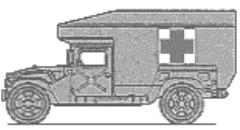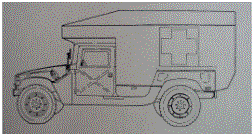M997 4-litter HMMWV* |
|
This ambulance is built on a HUMVEE frame and is equipped with Kevlar armor protection for the crew and patients. The armor protection is relative, not absolute. It is somewhat effective against low-speed fragments. It is relatively ineffective against high velocity small arms fire and not at all effective against mines. The M997 is capable of transporting:
The sequence of loading litter patients is right (passenger side) first, then left (driver side). The sequence is:
The most seriously injured is always loaded last and taken out first. This means that when the back of the ambulance is opened, the most seriously injured patient will always be on the left (driver side) and is the one removed first. Patients are normally loaded head-first into the ambulance. There are a number of reasons for this:
There are some exceptions to the general rules listed here.
|

|
For more information, read FM 8-10-6 Medical Evacuation in a Theater of Operations
*From Operational Medicine 2001, Health Care in Military Settings, NAVMED P-5139, May 1, 2001, Bureau of Medicine and Surgery, Department of the Navy, 2300 E Street NW, Washington, D.C., 20372-5300
Contents · Introduction · Learning Objectives · Textbook · Lectures · Procedures · Final Exam · Library · Laboratory · Pharmacy · Imaging · Forms · Videos · Search · About the Author · Contact Us
Military Obstetrics & Gynecology
© 2005
Medical Education Division,
Brookside Associates, Ltd.
All rights reserved
